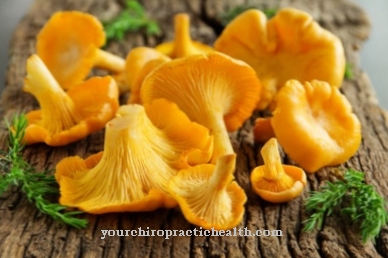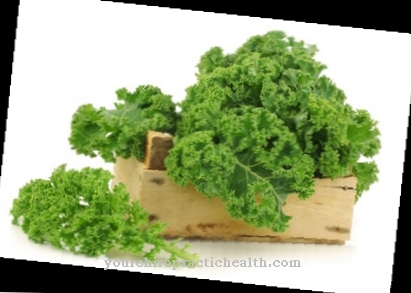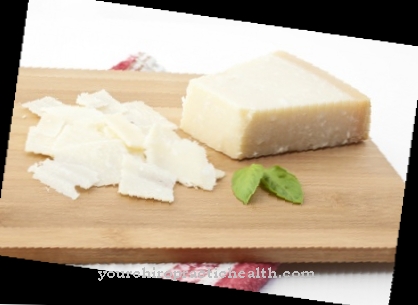The sour cherry is a cultivated plant with red fruits that has been known since ancient times. The stone fruits contain many vitamins and antioxidants. They are very popular as fresh fruit, spreads and cake ingredients.
What you should know about sour cherries

Like its relative, the black cherry (also called sweet cherry), the sour cherry belongs to the genus “Prunus” (Latin for plum tree). This name already shows that all known stone fruit plants such as cherry, almond, peach, plum and nectarine belong to this genus. According to genetic analyzes, the sour cherry originated as a hybrid form (bastard) from the bird cherry (Prunus avium) and the steppe cherry (Prunus fruticosa) on the border between eastern Turkey and Iran.
According to legend, the Roman general Lukullus brought this plant from the city of Kerasus, after which it is named, to Italy. From there it spread over the entire northern hemisphere. The cherry does not grow in the tropics because it needs a period of frost as a ripening signal. This is to prevent the flowers from appearing in autumn and then freezing to death. The sour cherry grows as a tree or shrub and can reach heights of 4 to 10 meters. Their trunk is red-brown, smooth and shiny and covered with many characteristic cork pores (lenticels). The leaves are ovate-elliptical and sawed on the edge (jagged like a saw). They are 6 to 10 cm long, up to 5 cm wide and are light green. The flowers emerge in groups of 2 to four flowers and are arranged side by side in an umbel shape. Each flower has 5 white petals and just as many sepals.
At the base of the inflorescence there are stipules, which are used to distinguish the sour cherry from the bird cherry. Like almost all trees, the sour cherry is a hermaphrodite and has pistils as well as pollen sacs. It is interesting that the sour cherry, in contrast to the sweet cherry, can fertilize itself and does not need any external pollinators (wind, insects). It can also fertilize sweet cherry trees. They bloom from April to May and in July the characteristic red drupes with flattened top and bottom are ripe.
The sour cherry is an important crop of which many varieties have been bred. It grows ideally on sandy, nutrient-rich soil. The largest producers of sour cherries are Turkey, Russia and Poland. Sour cherries are used in a wide variety of products.In Belgium there is even a sour cherry beer called "kriek lambic".
Importance to health
The red color of the cherry fruit is due to its high anthocyanin content. These substances from the class of polyphenols can be found in all blue, red or purple fruits. Anthocyanins have a very great antioxidant effect, i. H. they protect the cells from oxygen.
As can be seen from the browning of apples or the rusting of metal, oxygen has a strongly corrosive effect on many different substances. Cells protect themselves from aggressive oxygen atoms, which are also called “free radicals”, with antioxidant substances such as ascorbic acid (vitamin C) or anthocyanins. In various tests in the laboratory, an anti-inflammatory effect of anthocyanins and related plant pigments could also be determined. They inhibit the enzyme cyclooxygenase, which produces the neurotransmitter prostaglandin, which is important for inflammation. A decreased production of prostaglandin leads to less inflammation and less pain. In addition, the regular intake of anthocyanins can protect against hardening of the blood vessels (arteriosclerosis) and reduce the growth of certain types of cancer.
In contrast to other polyphenols, the anthocyanins of the cherry are not poisonous, even in high concentrations. Sour cherries naturally contain the hormone melatonin, which is produced in the human brain and regulates the waking and sleeping rhythm there. Problems falling asleep and staying asleep can therefore be improved by consuming cherries or cherry juice. Cherry juice has also been used with success against sore muscles and disorders of fat metabolism. But even without acute health problems, Prunus cerasus is worth consuming, as it contains a large amount of vitamins and minerals.
Ingredients & nutritional values
A 100 g serving of sour cherries consists of 12.2 g carbohydrates (sugar), 0.3 g fat, 1 g protein and 86.5 g water. In terms of vitamins, every fruit contains significant amounts of vitamin A, which is important for eye function, as well as vitamins B1, B2, B3, B5, B6, B9. In addition, there are the antioxidant vitamin C and vitamin K, which is essential for the functioning of blood and bones. There are also important minerals such as calcium, magnesium and phosphorus in the pulp. The calorific value of a 100g portion of sour cherries is 50 kcal or 209 kJ.
Intolerances & allergies
According to American statistics, around 6-8% of all children and 3-4% of adults are allergic to sour cherries, which does not have to include an allergy to sweet cherries. Symptoms range from irritation of the throat and nose to red eyes, diarrhea and nausea. The reasons for this are partly unclear, as no effective allergen (allergenic molecule) has been found in the tart cherry.
However, if other allergies are present, a cross-reaction can occur. This means that certain components of the sour cherry resemble the allergenic substance. The immune system of those affected may then also respond to the consumption of sour cherries. Cross-reactions have been proven in people who are allergic to birch pollen. Sour cherries can also be affected if you have a nut allergy. However, tart cherries also help many allergy sufferers to improve their symptoms because of their anti-inflammatory properties.
Shopping & kitchen tips
Sour cherries are a seasonal fruit that cannot be grown in greenhouses. Therefore, sour cherries are only available from their ripening month of July until around early autumn. If you have the opportunity, you should pick sour cherries yourself.
Children in particular like the task of picking the wonderful fruits from the tree, also directly into their mouths. Despite their appetizing appearance, like all fruits, cherries should be washed thoroughly before consumption. Because the careless handling of fruit in the kindergartens has led to a renewed appearance of parasites such as worms, which were actually believed to have been eradicated. Since cherries have a large amount of water and no hard shell, they dry out when stored for a long time and can only be stored for a long time if they are preserved.
Preparation tips
Cherries can be eaten fresh and are ideal for preparing many well-known types of cake, such as Black Forest cake, Danube waves and cherry streusel cake. To preserve cherries, you can soak them in water and sterilize them in the oven, soak them in alcohol or freeze them at -18 ° C. Cherries can of course also be processed into jam, jam or jelly and thus preserved. There are many recipes and suggestions on the internet.



























